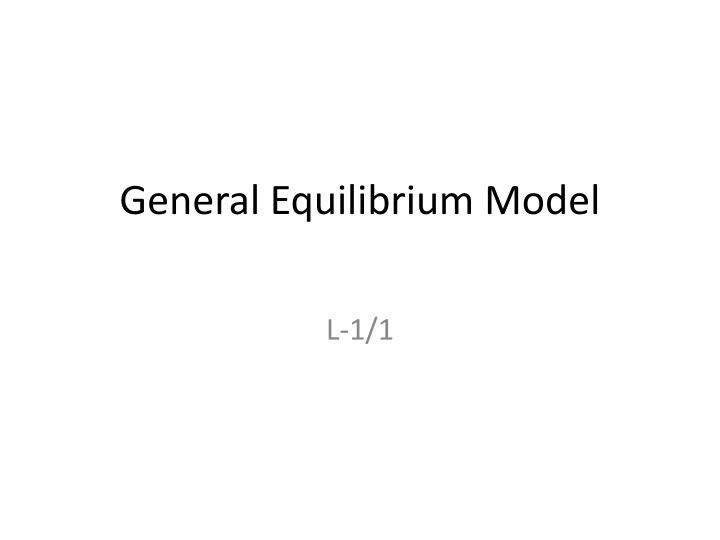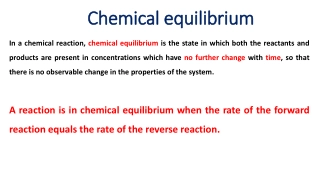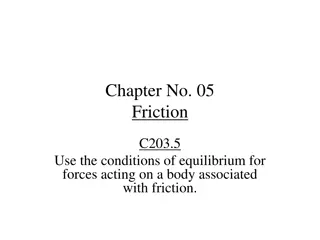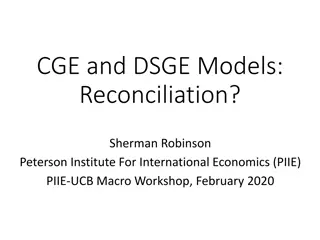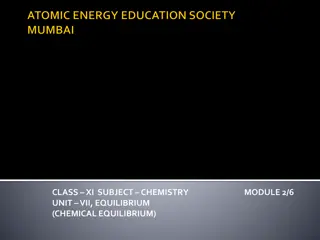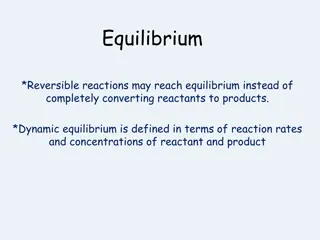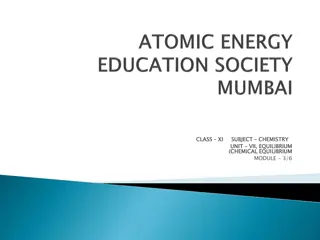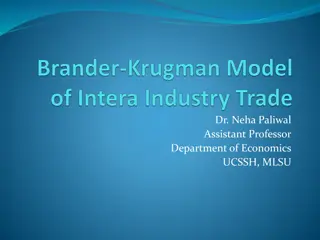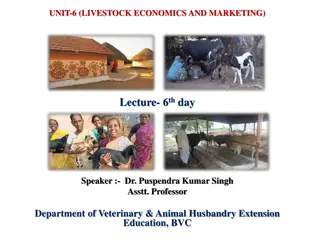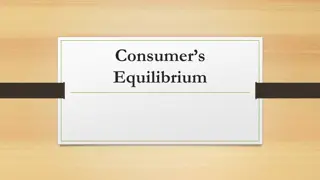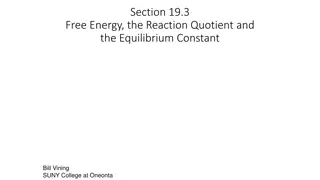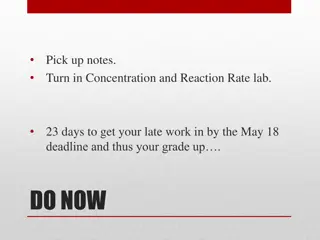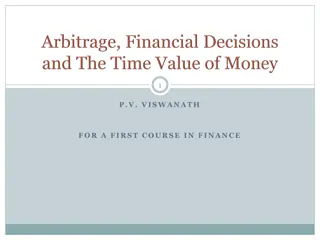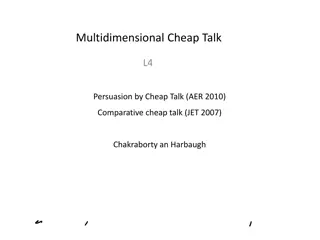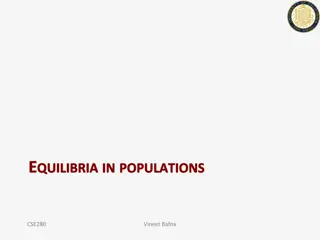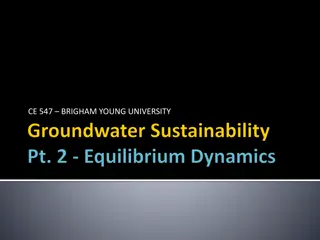General Equilibrium Model
General Equilibrium Model involves simultaneous equations for market clearing, with consumers maximizing satisfaction and firms maximizing profits. Leon Walras, a French economist, made significant contributions to the development of general equilibrium theory. Pareto Optimality, proposed by Vilfredo Pareto, focuses on social welfare improvement and efficiency through optimal resource allocation.
Download Presentation

Please find below an Image/Link to download the presentation.
The content on the website is provided AS IS for your information and personal use only. It may not be sold, licensed, or shared on other websites without obtaining consent from the author.If you encounter any issues during the download, it is possible that the publisher has removed the file from their server.
You are allowed to download the files provided on this website for personal or commercial use, subject to the condition that they are used lawfully. All files are the property of their respective owners.
The content on the website is provided AS IS for your information and personal use only. It may not be sold, licensed, or shared on other websites without obtaining consent from the author.
E N D
Presentation Transcript
Contents Partial vrs. General equilibrium Walrasian S System GE Paretian system of General Equilibrium
Walrasin General Equilibrium Model 1. It defined as state in which all the markets and decisions making units are in simultaneous equations. If each market is cleared at a positive price. Consumer maximising satisfaction. Firm maximising profits. Product market and factor market must be determined simultaneously. 2. GEM simultaneous equation model Millions of unknown with millions of equations. Behavioural equations: dd and ss functions Clearing market mechanism.
GEM: Lon Walras, L on Walras (French: 16 December 1834 5 January 1910) was a French mathematical economist and Georgist. He formulated the marginal theory of value (independently of William Stanley Jevons and Carl Menger) and pioneered the development of general equilibrium theory. Contributions Walras's law , General equilibrium. In 1874 and 1877 Walras published l ments d' conomie politique pure (1899, 4th ed.; 1926, d. d finitive), Inn English, Elements of Pure Economics (1954), translated by William Jaff . That work that led him to be considered the father of the general equilibrium theory. Walras's law implies that the sum of the values of excess demands across all markets must equal zero, whether or not the economy is in a general equilibrium. This implies that if positive excess demand exists in one market, negative excess demand must exist in some other market. Thus, if all markets but one are in equilibrium, then that last market must also be in equilibrium.
GEN: Leon Walras 1.All the prices and quantities in all markets determined simultaneously. 2.It is presented by a set equations. 3.Consumers have double role: he buys commodities and sells factors of productions to firms. Dd for commodities means quantities of commodities it produces. Ss of factor inputs means dd for factor inputs. Simultaneity means inter dependency. Millions of SEM with unknowns. 4. Three characteristics. Many markets=Many commodities=many factors of productions. Ss function=dd functions=clearing the market. Commodity market=dd functions= no. Of conumers. SS function=no of firms. No of equation= no.unknowns.
Economic efficiency: Pareto Optimality Velfredo Pareto (1848-1923): rejected the classical view of social welfare 1. Cardinal utility and additive nature 2. Interpersonal comparison of utility Pareto Criterion 1. Improvement 2. Optimality/efficiency Pareto improvement is a position from which it is possible to make someone better off without making someone worse off by any re-allocation of resources and outputs. Pareto optimality is a position from which it is impossible to make anyone better off without making someone worse off by any re-allocation of resources and outputs. Government policy change applies in case of PO.
Assumption of Pareto Optimality Each individual has his own ordinal utility function and poses a definite amount of each product and factor. Production function of every firm and state of technology is given and remains constant Goods are perfectly divisible. A producer tries to produce a given output with the least cost combination of factors Each individual wants to maximize his satisfaction. Every individual purchase some quantity of all goods. All factors of production are perfectly mobile.
Pareto Efficiency Conditions Exchange Efficiency Production Efficiency Product Mix Efficiency
Exchange Efficiency Exchange efficiency means the distribution of a given output of goods between individuals in a society should be such that it should not be possible to make someone better off without making anyone else worse off. The marginal condition for a Pareto Optimal or Efficient distribution of commodities among consumers requires that the MRS between two goods must be same for every individual who consumes them both. MRS xy of A = MRS xy of B
Explanation of the diagram Draw a Contract curve MRS between the two goods for individuals A and B are equal on the various points of the Contract curve CC . Any point outside the CC does not represent the equality of MRS. At point K, MRS xy of A is not equal to MRS xy of B. So movement from K to QS segment of any point on CC increase the social welfare.
Production Efficiency Pareto efficiency in production is possible by reallocating the resources is such a way that resources to produce more of some goods without producing less of some other goods. Use of Resources by a firm for production of a good or goods is efficient when it produces any given output at the minimum possible cost or a given cost outlays. The marginal condition for a Pareto optimal allocation of factors (inputs) requires that the MRTS between any pair of factors must be equal the same for any two firms producing any two products and using both the factors to produce the products. MRTS lk of A = MRS lk of B
Explanation of the diagram Draw a Contract curve MRTS for ne factors for another is the amount of one factors necessary to compensate the loss of the marginal unit of the anther so that the level of output remains the same. MRTS between the two goods for firm A and B are equal on the various points of the Contract curve CC . Any point outside the CC does not represent the equality of MRTS. At point K, MRTS xy of A is not equal to MRTS xy of B. So movement from K to QS segment of any point on CC increase the social welfare.
Product Mix efficiency The product mix efficiency means that allocation of resources among the production of various goods and services is in accordance with the preferences of the people. The marginal conditions for a Pareto Optimal or efficient composition of output requires that the MRPT (Marginal Rate of product transformation) between any two commodities be equal to the MRS between the same two goods. MRPTxy = MRSxy of A = MRSxy of B MRPT says the rate at which a good can be transformed into another. MRS xy = rate at which consumer are willing to exchange a good for another.
Explanation of the diagram AB is a community transformation curve. It represents an amount of X can be produced for any amount of Y with a fixed supply of available resources. MRSxy of A = MRSxy of B= MRPT at point R. R represents optimum combination of production in which commodities X and Y are being produced and consumed in OM and ON quantities. At point S, consumer is at lower IC.
Product Mix with Edgeworth Box TT is society product transformation curve. At L, ox1 of X and oy1 of Y is produced. Thus production at L and consumption at S can not be Pareto Optimum. In diagram 2, at point Q of TT , greater of Y and smaller of X is produced.
Critical evaluation of PC and PO 1. It is not completely free from value judgment. 2. PC can not be applied to judge the social desirability of those policies proposals which benefit some and harm others. Whenever, there is conflict of preferences of two individuals with respect to two alternatives, the criteria fails to rank those two alternatives no matter what the preferences of the rest of the individuals in the society might be. P.K. Paitnaik. 3. PC leaves a considerable amount of indeterminacy in the welfare analysis since every point in CC is pareto optimal. 4. PC accepts the prevailing income distribution and no attempt is made to find out an optimum distribution of income.
A.K. Sen Critique of PO A State can be PO with some people in extreme misery and others rolling in luxury, so long as the miserable cannot be made better off without cutting into the luxury of the rich. A.K. Sen He criticized the utility based PO. Utility is interpreted in happiness and desire-fulfillment. Utility does not always reflect well being. Well being is ultimately a matter of valuation and while happiness and fulfillment of desire may well be valuable for the person s well being, they cannot-on their own way or even together- adequately reflect the value of well being. Welfare or well being is also affected by political and environmental factors. A reorganization that gives everyone more income and leisure might not improve the welfare of the community if at the same time it limits individual freedom or requires the abandonment of cherished culture and traditions. 1. 2. 3. 4. 5.
Economic efficiency: Pareto Optimality Velfredo Pareto (1848-1923): rejected the classical view of social welfare 1. Cardinal utility and additive nature 2. Interpersonal comparison of utility Pareto Criterion 1. Improvement 2. Optimality/efficiency Pareto improvement is a position from which it is possible to make someone better off without making someone worse off by any re-allocation of resources and outputs. Pareto optimality is a position from which it is impossible to make anyone better off without making someone worse off by any re-allocation of resources and outputs. Government policy change applies in case of PO.
Assumption of Pareto Optimality Each individual has his own ordinal utility function and poses a definite amount of each product and factor. Production function of every firm and state of technology is given and remains constant Goods are perfectly divisible. A producer tries to produce a given output with the least cost combination of factors Each individual wants to maximize his satisfaction. Every individual purchase some quantity of all goods. All factors of production are perfectly mobile.
Pareto Efficiency Conditions Exchange Efficiency Production Efficiency Product Mix Efficiency
Exchange Efficiency Exchange efficiency means the distribution of a given output of goods between individuals in a society should be such that it should not be possible to make someone better off without making anyone else worse off. The marginal condition for a Pareto Optimal or Efficient distribution of commodities among consumers requires that the MRS between two goods must be same for every individual who consumes them both. MRS xy of A = MRS xy of B
Explanation of the diagram Draw a Contract curve MRS between the two goods for individuals A and B are equal on the various points of the Contract curve CC . Any point outside the CC does not represent the equality of MRS. At point K, MRS xy of A is not equal to MRS xy of B. So movement from K to QS segment of any point on CC increase the social welfare.
Production Efficiency Pareto efficiency in production is possible by reallocating the resources is such a way that resources to produce more of some goods without producing less of some other goods. Use of Resources by a firm for production of a good or goods is efficient when it produces any given output at the minimum possible cost or a given cost outlays. The marginal condition for a Pareto optimal allocation of factors (inputs) requires that the MRTS between any pair of factors must be equal the same for any two firms producing any two products and using both the factors to produce the products. MRTS lk of A = MRS lk of B
Explanation of the diagram Draw a Contract curve MRTS for ne factors for another is the amount of one factors necessary to compensate the loss of the marginal unit of the anther so that the level of output remains the same. MRTS between the two goods for firm A and B are equal on the various points of the Contract curve CC . Any point outside the CC does not represent the equality of MRTS. At point K, MRTS xy of A is not equal to MRTS xy of B. So movement from K to QS segment of any point on CC increase the social welfare.
Product Mix efficiency The product mix efficiency means that allocation of resources among the production of various goods and services is in accordance with the preferences of the people. The marginal conditions for a Pareto Optimal or efficient composition of output requires that the MRPT (Marginal Rate of product transformation) between any two commodities be equal to the MRS between the same two goods. MRPTxy = MRSxy of A = MRSxy of B MRPT says the rate at which a good can be transformed into another. MRS xy = rate at which consumer are willing to exchange a good for another.
Explanation of the diagram AB is a community transformation curve. It represents an amount of X can be produced for any amount of Y with a fixed supply of available resources. MRSxy of A = MRSxy of B= MRPT at point R. R represents optimum combination of production in which commodities X and Y are being produced and consumed in OM and ON quantities. At point S, consumer is at lower IC.
Product Mix with Edgeworth Box TT is society product transformation curve. At L, ox1 of X and oy1 of Y is produced. Thus production at L and consumption at S can not be Pareto Optimum. In diagram 2, at point Q of TT , greater of Y and smaller of X is produced.
Critical evaluation of PC and PO 1. It is not completely free from value judgment. 2. PC can not be applied to judge the social desirability of those policies proposals which benefit some and harm others. Whenever, there is conflict of preferences of two individuals with respect to two alternatives, the criteria fails to rank those two alternatives no matter what the preferences of the rest of the individuals in the society might be. P.K. Paitnaik. 3. PC leaves a considerable amount of indeterminacy in the welfare analysis since every point in CC is pareto optimal. 4. PC accepts the prevailing income distribution and no attempt is made to find out an optimum distribution of income.
A.K. Sen Critique of PO A State can be PO with some people in extreme misery and others rolling in luxury, so long as the miserable cannot be made better off without cutting into the luxury of the rich. A.K. Sen He criticized the utility based PO. Utility is interpreted in happiness and desire-fulfillment. Utility does not always reflect well being. Well being is ultimately a matter of valuation and while happiness and fulfillment of desire may well be valuable for the person s well being, they cannot-on their own way or even together- adequately reflect the value of well being. Welfare or well being is also affected by political and environmental factors. A reorganization that gives everyone more income and leisure might not improve the welfare of the community if at the same time it limits individual freedom or requires the abandonment of cherished culture and traditions. 1. 2. 3. 4. 5.
First Theorem of Welfare Economics Pareto optimality and allocation of resources One can make better off without making any one else worse off, an inefficient point. From in-efficienct point through improvement process, one can make Pareto efficient. First fundamental theorem of welfare economics 1. Maximization of social welfare or economic efficiency in general equilibrium frame. 2. It reflect general competitive equilibrium is Pareto optimal
First Theorem PC and Optimal Distribution of Goods or Exchange Efficiency 1.MRS xy of A = Px/Py 2.MRS xy of B =Px/Py 3. MRS xy of A = MRS xy of B PC and Optimal Distribution of Factors or Production Efficiency 1. MRTS lk of X =w/r 2. MRTS lk of Y = w/r MRTS lk of X =MRTS lk of Y
PC and Optimum Directions of Production General economic Efficiency This condition states that MRS between any two commodities for any consumer should be same as the MR of transformation (MRT) for the community between these two commodities. MC x/ MC y = Px/ Py MRT xy = MC x/ MC y = Px/ Py MRS xy = Px/Py Mrs xy =MRT xy
Criticism This is also called invisible hand theorem. General competitive equilibrium exists. Second order condition for equilibrium must fulfill. Externality in consumption and production do not exist. Pareto optimality and social justice
Theory of Consumer Surplus First formulated by Dupuit in 1884 to social benefits of public goods. It is further refined by and popularized by Principles of Economics in 1890. It is basis for welfare economics. Marshall s concept of CS is cardinal and interpersonal comparison of Utility. CS is simple difference between the price that one is willing to pay minus one actually pay for it for particular product. Greater the amount of money he is willing to pay, the greater the utility he obtained from it. CS = MU P X No. of unit of Commodity.
Marshalls CS Example: Consumption of Water. Two aspects are important to measure. 1. Total utility in terms of money 2. Total market value Assumptions: 1. Cardinal Measurement of Utility. 2. Marginal Utility of Money remain constant. 3. Different units of goods give different amount of satisfaction to the consumer.
Example of CS No of Units Marginal Value (in Rs) Price Total CS Net Marginal Benefits 1 20 12 8 2 18 12 6 3 16 12 4 4 14 12 2 5 12 12 0 6 10 12 -2 Total CS 20
CS under various situation (Marshallian Form of CS) 1. CS Under DD Curve 2. CS and Changes in price CS through Indifference curve Hicks and Allen is a ordinal concept. MU of money does not remain constant with the rise and fall in real income.
Hicksian Four Concept of CS 1. Price Compensating Variation 2. Price Equivalent Variation 3. Quantity Compensating Variation 4. Quantity Equivalent Variation 1. Price Compensating Variation PCV is defined by Hicks Maximum amount of money the consumer will be willing pay for the privilege of buying a commodity at a lower price so that he obtains the initial level of welfare. That is the level of welfare he obtained before the fall in price.
2. Price Equivalent Variation PEV is defined by Hicks as the minimum sum of money, the consumer will accept to receive for forgoing the opportunity of buying at a lower price, so that he obtains the subsequent level of welfare, which he reaches with lower price. 3. Quantity Equivalent Variation QCV is defined by Hicks As the maximum amount of money, a consumer will be willing to pay for the priviledge of buying a good at a lower price, if along with this privilege he is constrained to buy the quantity of the good, which he would buy at a lower price, in the absence of any compensating payment .
4. Quantity Equivalent Variation QEV is defined by Hicks as the minimum sum of money that the consumer will accept for forgoing the opportunity of buying the commodity at the lower price, provided he is constrained to buy the quantity of X, which he actually buys at the old higher price . If he is constrained to buy OA amount of X, he will accept QT amount of money for giving up the opportunity of buying the commodity at the lower price. This is because combination T gives same satisfaction as combination R at which point the consumer reaches with lower price of X.
Criticism of CS 1. CS is quite hypothetical, imaginary and illustrative. Sum total of money actually spent by him on the goods cannot be greater than his total money income. 2. It is based on invalid assumptions that different units of the goods give different amount of satisfaction to the consumer. 3. It ignores the interdependence between the goods that is the relations of substitute and complementary goods. 4. CS is hypothetical and imaginary: Prof. Nickolson says that it is difficult to say how much price a consumer would be willing to pay for a good rather than go without it. J.R. Hicks says the best way to look at the CS is to regard it as a means of expressing it in terms of money income gain which accrues to the consumers as a result of fall in price. 5. It is based on questionable assumption of cardinal measurability of utility and constancy of the marginal utility of money.
Conclusion Formulation of economic theory and policy Utility is more than price paid Adam Smith, Value in Use and Value in Exchange Example: salt, match box, news paper etc. Amenities and Recreational Facilities: Prof. Samuelson says How lucky the citizen of modern efficient communities really are? Marshallian CS was meant for formulating suitable fiscal policy, which maximizes the welfare of the people. Indirect Tax and Subsidies: CS and CBA:
Application of CS Three Major Areas 1. The Water Diamond Paradox of Value Theory 2. The effects of taxes and subsidies on Peoples welfare 3. CBA of public projects The Water Diamond Paradox of Value Theory Use value vrs market value Marginal valuation of a commodity reflects how much amount of money consumer is prepared to pay for a commodity. Market price of a commodity is determined not by its total use value but by its marginal valuation of marginal benefit which is turns depends upon the actually availability of quantity. Total valuation or satisfaction derived from water consumed is much greater compared with diamond but its marginal valuation is low due to its abundant supply.
The effects of taxes and subsidies Indirect tax and constant cost Industry Demand and SS of car Explain the loss of welfare due to tax Two components 1. Revenue collect by the govt. 2. Loss of welfare or excess of burden of sales taxation or dead weight loss Gain from subsidy Give the example of foodgrains Two components 1. Total expenditure burn by govt. 2. Net gain in welfare
CBA of Public Projects CBA means not only analysis of costs and benefits but also real costs and benefits in terms of satisfaction and resources. It also looks social point of view Give one example of fly over No. of journey per month and cost per journey Two components 1. Cost saving component 2. increase in consumer surplus
K.J Arrow as a Economist Kenneth Joseph "Ken" Arrow (August 23, 1921 February 21, 2017) was an American economist, writer, and political theorist. He was the joint winner of the Nobel Memorial Prize in Economics with John Hicks in 1972. To date, he is the youngest person to have received this award, at 51. His most significant works are his contributions to social choice theory, notably "Arrow's impossibility theorem", and his work on general equilibrium analysis. He has also provided foundational work in many other areas of economics, including endogenous growth theory and the economics of information.
Arrows Social Choice Social Choice and Individual Values Arrow s main contention that It is difficulty to set up reasonable democratic procedures for the aggregation of individual preferences into a social preferences for making a social choice . BS SWF f (goods and services consumed him not by others) SWF based on all individuals preference is impossible.
Arrow SWF Arrow has pointed out that individuals ordering of social states does not depend exclusively upon the commodities consumed but also on the amount of various types of collectives such as municipal services, parks, sanitation, erection of statues of famous men. Welfare results of collective activity can not be evaluated by an individual solely on the basis of his consumption. Individual ordering of social states will depend on his own consumption as well as on the consumption of others in the society.
Arrow conditions of Social Choice Value Judgments of a super man or dictator about social welfare may not be valid due to various types of biases in human mind. Arrow was the first welfare economist, who attempted to lay down reasonable necessary condition for achieving the social ordering. Dictator can make a choice through custom and tradition, spiritual on religious head in traditional society or by individuals comprising a society through voting. Dictatonial rule on religious and traditional society, social choice is comparutivelu each. Social choice in a democratic society based on individual ordering is diffcuilti.
